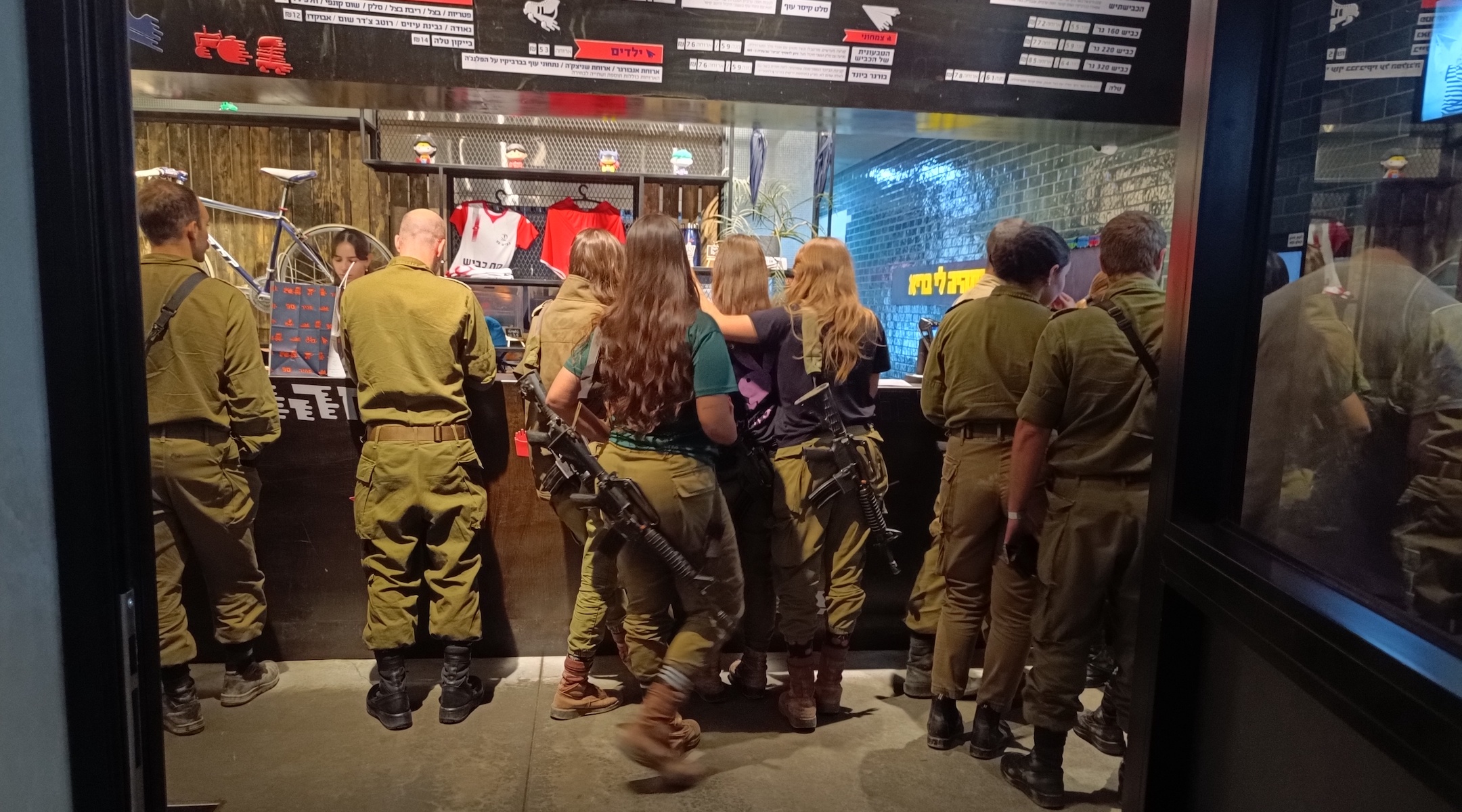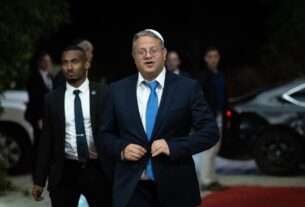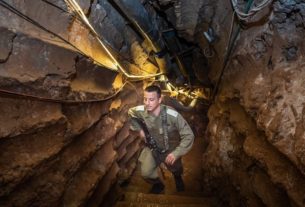MAHANAYIM JUNCTION, Israel ((JEWISH REVIEW)) — When Hamas attacked Israel on Oct. 7. Lea, a former infantry instructor in the Israel Defense Forces, cut short a trip to Central America and booked a ticket back to Israel, hoping to contribute to the war effort.
But like thousands of reserve soldiers, she has found herself far from the fighting in Gaza. After a brief period serving down south, she is one of the many IDF troops who have amassed on Israel’s northern border with Lebanon, girded for a full-scale fight with the Lebanese terror group Hezbollah that is threatening to erupt but has yet to materialize.
Like other soldiers up north, Lea, who did not share her full name due to IDF policy, doesn’t feel like passing her weeks up north is a waste of her time. In spite of the potential danger, she described her return to Israel and the army as a “safe space” for her — something that has kept her busy even during this waiting period.
“We are constantly in action,” she said recently while taking a break with dozens of other soldiers near a kiosk at this intersection, where two major highways intersect on their way to the Lebanese border at the town of Metula and the Syrian border in the Golan Heights. ”We keep going to different units to refresh them on how to use their mortars and quicken speed.”
How much those mortars and other weapons will be used remains an open question hanging over Israel and Lebanon as the IDF directs the brunt of its power toward Hamas in Gaza. Since Hamas’ Oct. 7 attack, the threat of Hezbollah joining the fight has been top of mind for leaders in Israel and across the region.
If that happens, the fighting could be even more extensive than Israel’s war in Gaza. Hezbollah, which is funded by Iran, is much larger than Hamas and has many more fighters and a bigger stockpile of weapons — including precision rockets that are far more dangerous than those launched by Hamas.
In Hezbollah’s last war with Israel, in 2006, more than 100 Israeli soldiers were killed in a ground invasion that did not end with a clear victor. In the 17 years since, Hezbollah has rebuilt its capacities for another round of conflict.
And sabres are rattling: A Hezbollah strike killed an Israeli civilian on Thursday, and earlier this week an anti-tank missile fired from Hezbollah injured 12 in Israel, following a week of relative calm during Israel’s ceasefire with Hamas, which Hezbollah largely abided by.
On Thursday, Israeli Prime Minister Benjamin Netanyahu threatened to rain the same firepower on Lebanon that Israel has brought to bear in Gaza.
“If Hezbollah chooses to start an all-out war, it will by its own volition turn Beirut and southern Lebanon, not far from here, into Gaza and Khan Younis,” the Gaza city where Israeli troops are now battling, he said in an address to troops on Thursday.
Hezbollah leader Hassan Nasrallah, meanwhile, has delivered several lengthy sermons expressing solidarity with Hamas, but has yet to indicate any clear plans for his group to escalate its fight with Israel.
Smoke rises during an exchange of fire between the Israeli military and Hezbollah on the border between Israel and Lebanon on December 3, 2023. (Ayal Margolin/Flash90)
“It seems like Hezbollah is trying to avoid an escalation or total war,” said Eyal Zisser, a professor at Tel Aviv University who studies the geopolitics of Israel’s northern borders, while cautioning that it’s difficult to predict what may unfold.
“We have to wait and see,” he said. “The war has not come to an end and you don’t know what will happen tomorrow.”
As a precaution following the Hamas attack, Israel evacuated tens of thousands of civilians from the Lebanese border area, including the 26,000-resident city of Kiryat Shemona. Hezbollah has since fired near-daily rockets at Israel and engaged in cross-border skirmishes with IDF troops. Seven Israeli soldiers and four Israeli civilians have been killed so far, as have more than 100 people in Lebanon — the vast majority of them Hezbollah fighters.
One prominent fear is that Hezbollah might attempt a ground invasion similar to Hamas’ Oct. 7 attack. Tal Beeri, who leads the Alma Institute, which focuses on Israel’s northern security, issued a paper last week arguing that Hezbollah’s special “Radwan” forces, who were specially trained by Iran to invade Israel by ground, have not been sufficiently weakened.
“In spite of the army’s preparedness in the north, it is still possible to invade Israel — while their original plans were for thousands of fighters to enter, they can still attempt it with a smaller group of hundreds,” Beeri wrote.
Complicating matters, Beeri does not believe that a diplomatic solution can address the challenge posed by Hezbollah: Previous attempts to demilitarize the region peacefully did not last.
“Diplomatic processes do not have teeth, as we learned from [United Nations Security Council Resolution] 1701,” he said, referring to a U.N. decision at the end of the 2006 war that called on Hezbollah to disarm. “There needs to be a reckoning with the clear, physical danger and the physical elimination of Radwan and its infrastructure.”
In the meantime, Hezbollah fighters have been seen roaming freely within sight of the Israeli-Lebanese border, and many residents from the evacuated communities say they will not return to their homes before the area is more fully secured.
Avital Salab, a mother of five from Kiryat Shmona, spent a few weeks in a Jerusalem hotel before renting an apartment “because you can’t really live a normal life with children in a hotel.” She said that she is “terrified” to return to her “beautiful, green home” because “we do not feel like they have done enough to make it safer.”
Soldiers who spoke with the Jewish Telegraphic Agency said they felt they were providing a vital service in guarding civilians against a looming threat, even if the war never arrives on their frontier.
“We are a first line of defense here to help keep the residents safe in the north against the threat that is Hezbollah,” said Jeremy, a native Midwesterner and former IDF paratrooper. “The whole big picture is to make sure that what happened down south does not happen again up north and the residents can feel a sense of security.”
The waiting game can be difficult. Jeremy, who is a parent, said the time away from his family has been a challenge. Guy, a 28-year old infantry soldier from Haifa, was glad that he was recently able to return home for his daughter’s first birthday before going back to his base. Oriel, another soldier at Mahanayim Junction, managed to return to base with an unexpected furry friend: his therapy dog, Zeus.
“The uncertainty of the northern front adds to the stress,” he said, adding that he hopes that petting Zeus will allow soldiers on his base to relax a bit.

Soldiers stand in line in November 2023 at a rest stop in Israel’s north that offers discounted fare to troops. (Eliyahu Freedman)
The soldiers were also getting a bit of a break at a shop called Route 90 Hamburgers and Beer, which has been offering a free beer tap and eats for soldiers during the war. Ran Sasson, the restaurant’s owner, said a few weeks ago that about 60 kegs had been served so far, along with about $16,000 worth of free burgers, “to help lift their spirits in a little way — without exaggerating — and also for ourselves to feel good by giving.”
He is no longer serving the fare for free, instead charging a discounted rate and soliciting donations to cover the difference. He’s also trying to collect gear for his IDF customers.
“We have turned into a little center here for any soldier that needs something —someone said that the rain is coming, we need wooden frames to not sleep on the floor, I helped arrange it for them from a local kibbutz,” Sasson said.
Israel’s Druze community in the north — which only a few months ago held major demonstrations against a planned windmill energy project in the Golan Heights — has rallied behind the army’s defense of the border.
“When we were first stationed here, there were Druze people driving trucks with a Druze flag that stopped and dropped off cookies and food in a show of support,” said Jeremy.
He added that American Jewish donations have also helped. The Orthodox Jewish high school he attended has offered to tutor kids whose parents are on reserve duty and has offered to send meals to his family. Other schools and volunteer efforts have mobilized to purchase gear and creature comforts for soldiers up north.
With winter approaching, Zack added that many soldiers feel “the rain is scarier than Hezbollah” and that there still is a need for more winter gear.
Most of the time, however, soldiers are on base, and are still “adjusting to the situation,” said Zack, who had just finished his term as an IDF infantry soldier and moved back to California when he learned of the Oct. 7 attack.
“After an initial shock, it is becoming more regular,” he said of serving up north. “We are on the edge of our seats most of the time, preparing in defensive positions, but our commander said honestly that nobody knows what will happen tomorrow.”
Ofek, 24, an artillery combat soldier waiting for an army shuttle to take him back to his base, agreed that “there is some tension in the air waiting.” But he added, “We feel like at the moment of truth we will do what we are doing in Gaza to Hezbollah.”
If Hezbollah joins the war, he said, “We will enter with full force.”




